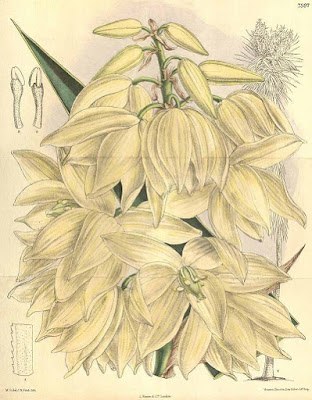 |
| Yucca gigantea in the Parc de la Ciutadella, Barcelona |
There has been some confusion with its botanical name as it was originally named and described as Yucca gigantea by French botanist and botanical author Charles Antoine Lemaire (1800–1871) in November 1859.
 |
| Yucca elephantipes - botanical image |
Under favourable conditions you can expect Yucca elephantipes to grow to approximately 9 m (30 ft) in height, with a spread of around 4.5 m (15 ft) for multi-stemmed specimens. The tough, sword-shaped leaves are spineless and can be up to 1.2 m (4 ft) in length on mature specimens. Avoid plant near buildings as Yucca elephantipes develop large root balls.
White bell-shaped flowers are produced in the summer on large terminal panicles up to 1 metre tall. Specimens grown as houseplants do not tend to bloom due to the lower light levels.
Yucca elephantipes is drought-tolerant species and can be grown in a variety of soils in a position that received full sun. It will perform best in well drained soils, however heavy or clay soils can be improved by digging in plenty of organic compost and grit. Avoid planting in frost pockets and soils prone to waterlogging.
It is not considered hardy in the cooler temperate regions of northern Europe although it have been known to successfully overwinter in the milders areas of southwest England and Ireland.
Main image credit -
For related articles click onto the following links:
RHS - Yucca Elephantipes
YUCCA FLACCIDA
YUCCA GLORIOSA
YUCCA RECURVIFOLIA







No comments:
Post a Comment